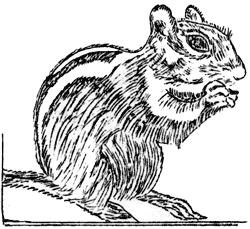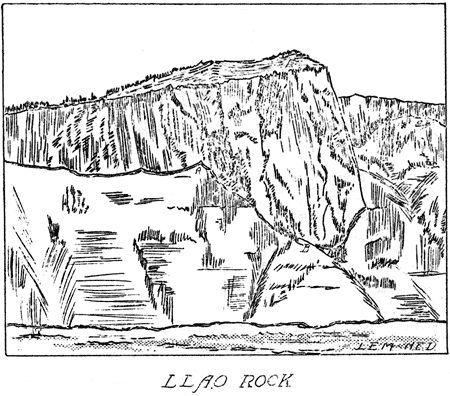Llao Rock, A Lava Flow Burying A Glacial Valley
By Wayne E. Kartchner, Ranger Naturalist, 1936-1937
Massive grandeur and sheerness combine to make Llao Rock, on the northwest side of Crater Lake, one of the outstanding features of the crater wall. The top of the rock, 8,046 feet above sea level, stands 1,884 feet above the surface of the lake.
In addition to being an impressive scenic features, Llao Rock is of great significance in the in the interpretation of the events that took place during the building of Mount Mazama, the name given to the peak, the destruction of which resulted in the crater in which Crater Lake is cupped. Llao Rock is a dacite lava flow, one of the most recent flows on the slopes of Mount Mazama. The evidence indicating whether the flow issued from the summit crater of the ancient peak or from a secondary vent on the slope has been destroyed. Regardless of the location of the vent from which the flow issued, there is distinct evidence that the dacite lava in moving down the mountain followed the course of a valley carved by a glacier. A sufficient quantity of lava issued to completely fill and overflow the glacial valley which has been carved to a depth of 500 to 600 feet, the maximum thickness of the flow being approximately 1,200 feet.
The conclusive evidence that the flow buried a glacial valley is as follows: (1) The cross-section of the base of the flow is distinctly U-shaped. Such a cross-section is characteristic of valleys carved by alpine glaciers. (2) Glacial scratches occur on rock surfaces on which the flow rests. The existence of glacial striations at points marked A and B on the sketch of Llao Rock which appears on the following page was determined by Ranger Naturalist Loren F. Miller. (3) Several feet of morainal material (glacial till) occurs immediately below the flow at the point marked B on the sketch.
The question has arisen as to whether the flow occurred while a glacier occupied the valley. Observations indicate that there was no glacier in the valley at the time of the flow. There is distinct evidence that the viscous lava came in contact with the morainal material, pebbles and small boulders being partially embedded in the underneath surface of the flow. Had ice existed in the valley at the time of the flow there would undoubtedly be evidence of caves formed as the ice melted out beneath the flow. Evidence of such caves is entirely lacking.
From the evidence presented it may be concluded that Llao Rock represents a recent lava flow which filled and buried a glacial valley carved to a depth of 500 to 600 feet on the northwest slope of Mount Mazama, and that the flow occurred when the valley was free of ice.
Mammals On Wizard Island
By R. R. Huestis, Ranger Naturalist
 On July 28, 1937, twenty delusion (live) mouse traps were set along the trail leading to the top of Wizard Island. The traps were set among lava rocks and under logs. These traps took two adult female Mazama red-backed mice, Clethrionomys californicus mazama (Merriam). These mice are relatively rare specimens in trap-lines and very little is known about their life history. It is an interesting fact that the type specimen of this subspecies was taken by C. Hart Merriam and Vernon Bailey on the south side of Crater Lake, August 15, 1896. The two trapped specimens closely resemble in color and measurements the specimens described by Bailey.* The measurements tabulated below are in millimeters.Three of four species of diurnal mammals have been reported as living on Wizard Island in Crater Lake. The mammals are, the brown coney, Ochotona princeps brunnescens Howell; the golden-mantled ground squirrel, Callospermophilus chrysodeirus chrysodeirus (Merriam); and a chipmunk. The latter might be Allen’s Chipmunk, Eutamias townsendii senex(Allen), or the smaller Eutamias amoenus amoenus (Allen), the Klamath Chipmunk. Both species of chipmunks may have been seen.
On July 28, 1937, twenty delusion (live) mouse traps were set along the trail leading to the top of Wizard Island. The traps were set among lava rocks and under logs. These traps took two adult female Mazama red-backed mice, Clethrionomys californicus mazama (Merriam). These mice are relatively rare specimens in trap-lines and very little is known about their life history. It is an interesting fact that the type specimen of this subspecies was taken by C. Hart Merriam and Vernon Bailey on the south side of Crater Lake, August 15, 1896. The two trapped specimens closely resemble in color and measurements the specimens described by Bailey.* The measurements tabulated below are in millimeters.Three of four species of diurnal mammals have been reported as living on Wizard Island in Crater Lake. The mammals are, the brown coney, Ochotona princeps brunnescens Howell; the golden-mantled ground squirrel, Callospermophilus chrysodeirus chrysodeirus (Merriam); and a chipmunk. The latter might be Allen’s Chipmunk, Eutamias townsendii senex(Allen), or the smaller Eutamias amoenus amoenus (Allen), the Klamath Chipmunk. Both species of chipmunks may have been seen.
| Total Length | Tail Vertebrae | Foot | Ear |
| 162.8 | 51.5 | 19.0 | 11.2 |
| 157.2 | 53.7 | 18.4 | 12.0 |
It may be seen from the above that the two specimens of Mazama red-backed mice have tails about one-half the length of the body and small ears. They also have small eyes. They are bright reddish brown along the back with greyer flanks and a pale cream-colored ventral surface.
On August 8 twenty delusion mouse traps and twenty large and small snap traps were set on the north slope of Wizard Island. The delusion traps took four deer mice,Peromyscus maniculatus ssp., and the snap traps took one Peromyscus, some coneys and golden-mantled ground squirrels. Only one Peromyscus was an adult. It measured 172.3 x 81.8 x 22.3 x 18.4. These measurements are duplicated by specimens taken along the rim; in color the specimen presented no obvious differences from the mainland type. No chipmunks were taken at this time nor in a previous night’s trapping, and none have been seen on the island this year (1937).
The mammalian fauna of Wizard Island is interesting because no one knows how the animals got there. Coneys are common inside the rim of Crater Lake but they never venture any distance from the home rock slide. Swimming Skell Channel, the narrowest arm of water between the island and the mainland, would be quite out of character for them. It seems improbable that they would venture out of their winter retreats and cross the island on ice. Golden-mantled ground squirrels are in hibernation in the winter. It seems quite improbable that they would swim across although this method of transportation may be possible. Peromyscus swim readily. They could easily have been transported by a boat, a method of travel which would also be open to squirrels and chipmunks. The habits of red-backed mice are insufficiently know to venture comment on how they got to Wizard Island.
While visiting the island during the summer months Dr. R. M. Bond found signs indicating the presence of either a fox or a bobcat. It seems quite possible that a more extended investigation might show, in addition to deer mice, Mazama red-backed mice, ground squirrels, and coneys, the presence of which has already been determined, or past occupancy, of still other mammals of Wizard Island.
*Bailey, Vernon, The Mammals and Life Zones of Oregon, N. Amer. Fauna No. 55, U.S.D.A. Bur. of Biol. Sur., June 1936.



